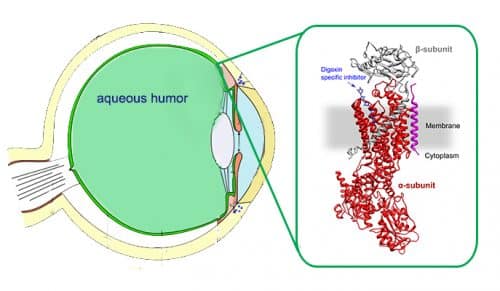Glaucoma affects the sight of millions of people, and is among the main causes of blindness worldwide. Weizmann Institute of Science scientists, in collaboration with ophthalmologists, have developed a new compound that may help treat the main symptom of glaucoma - increased intraocular pressure

Glaucoma affects the sight of millions of people, and is among the main causes of blindness worldwide. Weizmann Institute of Science scientists, in collaboration with ophthalmologists, have developed a new compound that may help treat the main symptom of glaucoma - the increase in intraocular pressure.
As part of the regular operation of the eye, it secretes a liquid that washes the cornea and the lens of the eye, and drains back into the blood system. The production of the fluid in the eye is controlled, among other things, by an enzyme called the sodium-potassium pump, which is located in the cell membrane. This pump takes sodium ions out of the cell, and puts potassium ions into it. At the same time, the pump creates a flow of sodium ions and other ions into the front segment of the eye, accompanied by the entry of water - which is the intraocular fluid. In those with glaucoma, the liquid does not drain properly into the blood system, or it is formed in too large quantities, resulting in increased intraocular pressure.
The new materials developed by the institute's scientists as a possible treatment for glaucoma lower the intraocular pressure by blocking the activity of the sodium-potassium pump, and reducing the production of fluid in the eye. But blocking the pump's activity is not a simple goal. The biggest challenge lies in the fact that these pumps are found in almost every cell and tissue in the body. Because of this, blocking their activity may not only curb the increase in intraocular pressure, but also sabotage many other processes that take place in the body, and cause unwanted side effects. In fact, "Digoxin", the classic drug for blocking the activity of the sodium-potassium pump, suffers from this very limitation. This drug, which is extracted from the digitalis plant (purple foxglove) and has been in medical use for over 200 years, mainly causes the heart muscle to beat faster, so it is not used to treat glaucoma - for fear of the unwanted side effects.
as which was recently reported In the scientific journal "Records of the National Academy of Sciences of the USA" (PNAS), the new compound developed by the scientists of the institute is a derivative of "digoxin", and is specifically aimed at treating the effects of the sodium-potassium pump on the eye, but not on other tissues. Moreover, it is administered through eye drops, which further reduces the side effects.
says the head of the research team, Prof. Steven Karlish, from the department of biomolecular sciences at the institute: "We were able to develop the new compound thanks to a unique combination of the areas of specialization of the members of our research group, including expertise in the biochemistry of the pump, in chemical syntheses, and in physiological tests." Thus, for example, staff scientist Dr. Adriana Katz specializes in membrane proteins. "The sodium-potassium pump has two main subunits, alpha and beta, and each of them has several forms characteristic of each tissue," says Dr. Katz. "In the eye cells that produce the liquid, the pump consists of two forms of these subunits, alpha-2 and beta-3."
"We synthesized dozens of digoxin derivatives," says Dr. Daniel Tal, also a faculty scientist from Prof. Karlish's group, and has four decades of experience in chemical synthesis, especially of steroids such as "digoxin" and its derivatives. "In the end, we chose the most effective derivative in blocking the alpha-2 and beta-3 form of the pump, so the activity of this derivative is focused on the eye."
Dr. Katz adds: "In experiments on rabbits, our 'digoxin' derivative lowered intraocular pressure or more effectively prevented its formation compared to the common glaucoma drug. Furthermore, when combined with the same drug, our compound was effective for 24 hours. This is a big advantage, because a medicine given once a day is more convenient to use." It is also important to note that no side effects were observed in animal experiments.
Company "knowledge", the technological applications arm of the Weizmann Institute of Science, registered two patents on the new derivatives of "digoxin". These developments are of great importance, since the existing medications for the treatment of glaucoma are not effective for all patients, or lose their effectiveness over time, which sometimes leads to the need for surgery.
The research group also included research student Michael Habak and staff scientist Dr. Efrat Ben Zeev, from the Israeli National Center for Personalized Medicine named after Nancy and Steven Grand. The scientists worked in close cooperation with ophthalmologists Dr. Yaniv Barkana and Dr. Dan Heller from the Assaf Harofeh Medical Center, and Dr. Aryeh Markovich and Dr. Bilal Rabha from the Kaplan Medical Center.

One response
We want an article about the physical research at the Weizmann Institute. Unless the scientist's agreement with the magazine is only for articles on a certain topic, then it is understandable. Mordechai Milgrom's MOND theory, works on multi-particle systems, mathematical theories in number theory on elliptic spaces of numbers. There's more to it than microbiology. Even Professor Iran Segal - who is often featured here, is actually a mathematician and computer scientist and operates BIG DATA tools for deciphering DNA information.